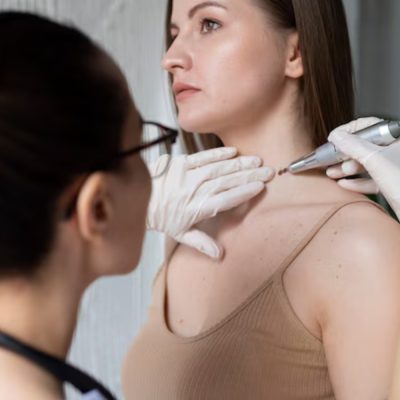Skin Growth Removal
Some skin growths can be a source of cosmetic concern or discomfort. At times, they may even pose health risks. Skin growth removal is a common procedure performed to eliminate unwanted growths on the skin, enhancing appearance and alleviating symptoms.

Types of Skin Growths
Understanding the type of skin growth is essential for selecting the appropriate removal method. Common types of skin growths include:
Usually benign pigmented spots or growths on the skin that can vary in size and color. Some moles may require removal if they change in appearance or pose a cancer risk.
Small, soft, benign growths that often appear in areas where the skin folds, such as the neck, armpits or groin. Skin tags are typically harmless but can be removed if they cause irritation or cosmetic concerns.
Caused by the human papillomavirus (HPV), warts are rough, raised growths that can appear anywhere on the body. They are contagious and may spread if not treated.
Non-cancerous growths that appear as brown, black or tan spots. These growths are typically harmless but can be removed for cosmetic reasons.
Fluid-filled sacs that develop under the skin, often caused by blockages in the hair follicles or oil glands. Cysts may require removal if they become infected or cause discomfort.
Rough, scaly patches on the skin caused by sun exposure. While not cancerous, they have the potential to develop into squamous cell carcinoma and may be removed as a precaution.
Soft, fatty lumps that grow under the skin. While generally harmless, lipomas can be removed if they become painful or for cosmetic reasons.
What is Skin Growth Removal?
Skin growth removal involves the elimination of various types of benign or malignant growths from the skin. The decision to remove a skin growth may be based on medical necessity, such as the risk of cancer, or cosmetic reasons to improve the appearance of the skin.
Depending on the type and location of the growth, different removal techniques are employed, including surgical excision, laser therapy, cryotherapy and electrocautery. Consulting with a qualified dermatologist is crucial to determine the most appropriate method for skin growth removal based on the specific characteristics of the growth.
Method & Treatment for Skin Growth Removal
Common Removal Techniques
Surgical Excision
This involves cutting out the skin growth using a scalpel. It is commonly used for moles, cysts, and other deeper growths. Stitches may be required if the growth is large.
Laser Therapy
A laser is used to remove or vaporize the growth. It is suitable for warts, moles and certain types of pigmented lesions. This method is precise and minimizes damage to surrounding tissue.
Cryotherapy
Liquid nitrogen is applied to freeze and destroy the growth. This method is commonly used for warts, skin tags, and actinic keratoses. The treated area may blister and scab over before healing.
Electrocautery
Uses electric current to burn off the growth. It is effective for removing skin tags, warts, and small moles.
Shave Excision
The growth is shaved off at the skin level, typically used for moles or seborrheic keratoses that are raised above the skin surface.
Chemical Peels
Involves applying a chemical solution to the skin, causing the growth to peel off over time. This is often used for actinic keratoses and other superficial growths.
Dermabrasion
A rotating instrument removes the outer layers of skin, useful for treating growths that are confined to the skin’s surface.
Post-Treatment Care
Proper aftercare is essential to promote healing and minimize scarring. This includes keeping the area clean, applying prescribed ointments, and protecting the skin from sun exposure.
Applied Areas for Skin Growth Removal
Skin growth can form on various parts of the body. The removal method varies on the type of growth, size and its location, including:
Face
For cosmetic reasons, to remove unpleasant looking growths such as moles or seborrheic keratoses.
Neck & Armpits
Common areas for skin tags, which can be irritated by clothing or jewelry.
Hands & Feet
Areas frequently affected by warts due to exposure to the HPV virus.
Trunk & Limbs
Common sites where cysts, lipomas, or other benign growths may develop.
Scalp
Removal of growths that interfere with hair care or cause discomfort.
Precautions and Risks of Skin Growth Removal
- Always have skin growths initially evaluated by a trained dermatologist to rule out malignancy before removal.
- Inform your doctor of any medications or supplements, especially blood thinners, as these can increase bleeding risk.
- Post-procedure, protect the treated area from sun exposure to prevent pigmentation changes or scarring.
- As with any minor surgical procedure that breaks the skin, there is a risk of infection. Proper pre and post-surgical care helps minimize the risk.
- Depending on the removal method, size of the growth and the individual’s healing response, some scarring may occur.
- Some growths, particularly warts, may recur after removal.
- Post-inflammatory hyperpigmentation or hypopigmentation can occur, particularly in individuals with darker skin tones.
Post-Procedure Signs to Look Out For
Mild Redness & Swelling: This is expected and should subside within a few days.
Scabbing or Crusting: This is normal as the wound heals. Avoid picking or scratching the scabs to prevent scarring.
Pain or Discomfort: Typically, pain is mild and is manageable with over-the-counter pain killers.
Signs of Infection: Watch for increased redness, warmth, swelling, pus or fever. Contact your dermatologist if these occur.
Complementary Cosmetic Procedures for Better Outcomes
To enhance the aesthetic outcome after skin growth removal, consider pairing the procedure with:
Laser Resurfacing
Helps smoothen and rejuvenate the skin after growth removal, minimizing scars and improving texture.
Microneedling
Can be used post-removal to reduce the appearance of scars and promote collagen production.
Chemical Peels
Useful for addressing pigmentation changes or refining skin texture after growth removal.
Platelet-Rich Plasma (PRP) Therapy
PRP therapy can promote healing and improve skin tone and texture.
Hydrafacial
Can be used to cleanse and hydrate the skin, enhancing overall skin appearance and health.
